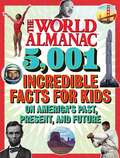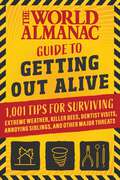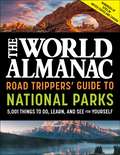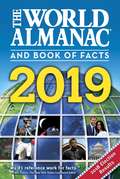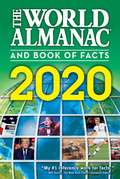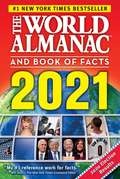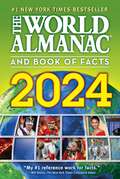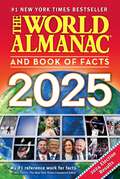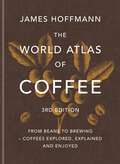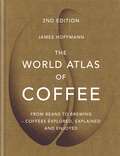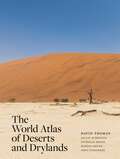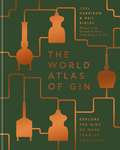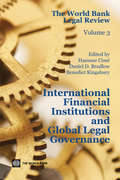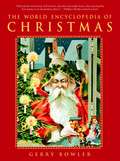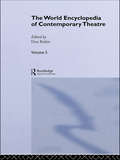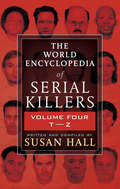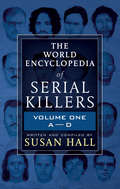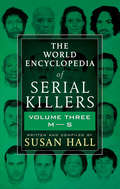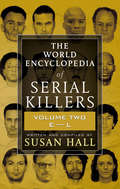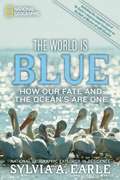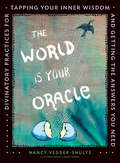- Table View
- List View
The World Almanac 5,001 Incredible Facts for Kids on America's Past, Present, and Future
by World Almanac Kids™From the #1 New York Times bestselling World Almanac™ comes a full‑color, full‑of‑fun, oversize book packed with thousands of awesome facts about America—everything about the 50 states and beyond. Kids want to learn about the world around them, and with this engaging, colorful collection of facts, figures, photographs, and fun, they will. Perfect for home or for school, and a great gift for any curious reader, here are thousands of fascinating and surprising facts about about the United States, from its natural resources and landmarks, to the first peoples to inhabit and explore the Americas, to the innovation and diversity of the nation in the 21st century––and everything in between. Kids, teachers, and families will find timely and timeless information on an enormous variety of subjects. It will give readers hours and hours of fun while it educates and illuminates.
The World Almanac 5,001 Incredible Facts for Kids on Nature, Science, and People
by World Almanac Kids™From the #1 New York Times bestselling World Almanac™ comes a full‑color, full‑of‑fun, oversize book packed with thousands of awesome facts about science, nature, and people—everything on planet Earth and beyond. Kids want to learn about the world around them, and with this engaging, colorful collection of facts, figures, photographs, and fun, they will. Perfect for home or for school, and a great gift for any curious reader, here are thousands of fascinating and surprising facts about almost everything: Animals—Dogs, cats, snakes, insects, spiders, sharks, and moreCulture—Art, holidays, food, movies, and moreDisasters—Earthquakes, shipwrecks, floods, storms, and moreGeography—Oceans, mountains, continents, habitats, and moreGeology—Volcanoes, tectonics, minerals, gems, and moreHuman Body and Medicine—Diseases, organs, senses, and other weird and wonderful human body facts.Record-setters—All about the biggest, smallest, fastest, tallest, and moreSpace—The moon, stars, planets, human spaceflight, and moreSports—Basketball, baseball, football, hockey, Olympic, and soccer superstars past and present, and moreTechnology—Computers, drones, inventions, and more The World Almanac™ 5,001 Incredible Facts for Kids on Nature, Science, and People provides kids, teachers, and families timely and timeless information on an enormous variety of subjects. It will give readers hours and hours of fun while it educates and illuminates.
The World Almanac Guide to Getting Out Alive: 1,001 Tips for Surviving Extreme Weather, Killer Bees, Dentist Visits, Annoying Siblings, and Other Major Threats
by World AlmanacThe World Almanac's brand-new, full-color survival handbook, offering tips and tricks for getting through life in one piece! This is not your parents' scouting survival manual! From extreme weather to just leaving the house every day, who doesn't have a lot to be worried about? The World Almanac Guide to Getting Out Alive prepares readers to face any obstacle head-on, with the best possible action. Whether you're worried about surviving something uncommon (like a volcanic eruption, shark attack, or plane crash) or something more common (like going to the dentist or giving a presentation in front of your whole class), this guide has escape routes, strategies, and other ways to get to safer ground––or avoid trouble in the first place! Chapters include: Survival Skills 101 First Aid Basics Animal Attacks Dangerous Situations Well, I&’m Lost When Nature Attacks Family Troubles Body Language Occupational Hazards (Surviving School and Work) Social Situations The World Almanac Guide to Getting Out Alive can prepare you for just about anything that life might throw your way––and turn any possible cause for concern into empowered action.
The World Almanac Places to Go Before You Can't
by John RosenthalFrom the #1 New York Times bestselling World Almanac comes a full-color book celebrating the world&’s most breathtaking, exciting, and astonishing attractions––places you&’ll want to visit before it&’s too late. Add to your personal list of must-see destinations with this exceptional collection of locales, from the familiar to the far-flung. The World Almanac Places to Go Before You Can&’t gathers gorgeous photography and local details about some of the world&’s greatest, most eye-popping sites. Gain a new perspective on attractions closer to home, from North Carolina&’s Outer Banks to Yosemite&’s ancient sequoias and stunning waterfalls. Or complete your bucket list a little further afield, whether you&’re drawn to the Great Barrier Reef or the Galapagos. With an emphasis on experiencing all you can before these places disappear or change forever, this guide tempts curious travelers of all types to begin making travel plans tomorrow. Hundreds of enticing color images are complemented by expert advice on where to go, when to travel, and how to make the most of the experience while respecting these ever-changing sites and their caretakers.
The World Almanac Road Trippers' Guide to National Parks: 5,001 Things to Do, Learn, and See for Yourself
by World AlmanacFrom the #1 New York Times bestselling World Almanac comes a brand-new, full-color book celebrating the National Parks––"America's best idea"––and providing a valuable resource for first-time visitors and longtime park fans alike. From the rugged, rocky coasts of Acadia to the geysers and hot springs of Yellowstone to the in-your-face beauty of the Grand Canyon, the national parks of North America offer visitors a new sight or bucket-list-worthy experience at every turn. The World Almanac Road Trippers' Guide to National Parks provides detailed history, itineraries, visitor information, gorgeous photography, recommended hiking routes, and other not-to-be-missed sites and activities for anyone seeking to make the most out of the many resources of the national parks systems of the United States and Canada. Divided into travel regions for convenient research and planning whether the trip length is a day or a year, this is a tool eager travelers will use to discover new sites and off-the-beaten-path destinations again and again.
The World Almanac and Book of Facts 2019 (World Almanac and Book of Facts)
by Sarah Janssen.Get thousands of fully searchable facts at your fingertips with this essential resource.The World Almanac® and Book of Facts is America's top-selling reference book of all time, with more than 82 million copies sold. For more than 150 years, this compendium of information has been the authoritative source for all your entertainment, reference, and learning needs. The 2019 edition of The World Almanac reviews the events of 2018 and will be your go-to source for questions on any topic in the upcoming year. Praised as a "treasure trove of political, economic, scientific and educational statistics and information" by The Wall Street Journal, The World Almanac and Book of Facts will answer all of your trivia needs on demand—from history and sports to geography, pop culture, and much more. Features include: The World at a Glance: This annual feature of The World Almanac provides a quick look at the surprising stats and curious facts that define the changing world and includes a sneak peek at upcoming milestone celebrity birthdays in 2019. Statistical Spotlight: A popular new feature highlights statistics relevant to the biggest stories of the year. These data visualizations provide important context and new perspectives to give readers a fresh angle on important issues. This year’s statistics will spotlight immigration, refugees, and asylum claims; the rising number and historic cost of natural disasters; and the nationwide opioid epidemic. 2018 Election Results: The World Almanac provides a comprehensive look at the entire 2018 election process, including complete Election Day results for House, Senate, and gubernatorial races. World Almanac Editors' Picks: Senior Moments: With leading athletes like Tom Brady and Serena Williams approaching middle age while still at the top of their game, The World Almanac editors look at the sports world’s most memorable achievements by aging athletes. The Year in Review: The World Almanac takes a look back at 2018 while providing all the information you'll need in 2019. 2018—Top 10 News Topics: The editors of The World Almanac list the top stories that held the world's attention in 2018, covering the U.S. Supreme Court nomination process, historic negotiations with North Korea, a year of #MeToo developments, and much more. 2018—Year in Sports: Hundreds of pages of trivia and statistics that are essential for any sports fan, featuring complete coverage of the Winter Olympic Games in South Korea, World Cup men's soccer, the World Series, improved MLB player stats, and much more. 2018—Year in Pictures: Striking full-color images from around the world in 2018, covering news, entertainment, science, and sports. 2018—Offbeat News Stories: The World Almanac editors select some of the most unusual news stories of the year, from the parade commemorating a team’s winless NFL season to the “bananas” lawsuit over a Halloween costume. World Almanac Editors' Picks: Time Capsule: The World Almanac lists the items that most came to symbolize the year 2018, from news and sports to pop culture. Other New Highlights: Brand-new statistics on crime rates for all major U.S. cities, U.S. trade and immigration policies, 2018 tax cuts, DACA recipients, mobile app and tech usage, student loan debt, income inequality, and much more.
The World Almanac and Book of Facts 2020 (World Almanac and Book of Facts)
by Sarah JanssenGet thousands of facts at your fingertips with this essential resource.The World Almanac® and Book of Facts is America&’s best-selling reference book of all time, with more than 82 million copies sold. For more than 150 years, this compendium of information has been the authoritative source for all your entertainment, reference, and learning needs. The 2020 edition of The World Almanac reviews the biggest events of 2019 and will be your go-to source for questions on any topic in the upcoming year. Praised as a &“treasure trove of political, economic, scientific and educational statistics and information&” by The Wall Street Journal, The World Almanac and Book of Facts will answer all of your trivia needs effortlessly—from history and sports to geography, pop culture, and much more. Features include: Decade in Review: As the &‘teens&’ decade closes, take a look at the highlights, low points, and everything-in-between of the past 10 years. From the introduction of Obamacare and iPads in 2010 to &“Old Town Road&” and the immigration policy debate in 2019, The World Almanac provides a recap of events and puts into perspective just how much has—and hasn&’t—changed in the last 10 years. 2020 Election Preview: The World Almanac provides a comprehensive look at the entire 2020 election process, including a calendar of state primaries and caucuses. Also includes 2019 election results for governors&’ seats and special congressional elections. World Almanac Editors&’ Picks: Never Say Die: With Tiger Woods achieving the seemingly impossible in 2019 with his 15th major title—his first Masters win in 14 years—the editors list their favorite major comeback moments from athletes across the sports universe. The World at a Glance: This annual feature of The World Almanac provides a quick look at the surprising stats and curious facts that define the changing world. Statistical Spotlight: A popular annual graphic feature highlights statistics relevant to the biggest news of the year. These data visualizations provide important context and new perspectives to give readers a fresh angle on key issues. The Year in Review: The World Almanac takes a look back at 2019 while providing all the information you'll need in 2020. 2019—Top 10 News Topics: The editors of The World Almanac list the top stories that held the world's attention in 2019. 2019—Year in Sports: Hundreds of pages of trivia and statistics that are essential for any sports fan, featuring coverage of the women&’s World Cup soccer tournament; a preview of the upcoming 2020 Olympic Games in Tokyo, Japan; the World Series, improved MLB player stats, and much more. 2019—Year in Pictures: Striking full-color images from around the world in 2019, covering news, entertainment, science, and sports. 2019—Offbeat News Stories: The World Almanac editors select some of the most unusual news stories of the year. World Almanac Editors' Picks: Time Capsule: The World Almanac lists the items that most came to symbolize the year 2019, from news and sports to pop culture. New Sections: Reorganized chapters on &“Food and Agriculture,&” &“Educational Statistics,&” and &“Colleges and Universities&” make it easier to find information about subjects like nutrition, student loans, a directory of colleges, and much more. Other New Highlights: New statistics on income tax reform, top-grossing movies, biggest YouTube channels, religious populations in the U.S. and worldwide, and much more.
The World Almanac and Book of Facts 2021 (The World Almanac and Book of Facts)
by Sarah Janssen#1 New York Times Bestseller! Get thousands of facts at your fingertips with this essential resource: business, the arts and pop culture, science and technology, U.S. history and government, world geography, sports, and so much more.The World Almanac® is America&’s bestselling reference book of all time, with more than 83 million copies sold. For more than 150 years, this compendium of information has been the authoritative source for school, library, business, and home. The 2021 edition of The World Almanac reviews the biggest events of 2020 and will be your go-to source for questions on any topic in the upcoming year. Praised as a &“treasure trove of political, economic, scientific and educational statistics and information&” by The Wall Street Journal, The World Almanac and Book of Facts will answer all of your trivia needs effortlessly. Features include: 2020 Election Results: The World Almanac provides a comprehensive look at the entire 2020 election process, from the roller coaster of the early primaries to state and county presidential voting results and coverage of House, Senate, and gubernatorial races.2020 Coronavirus Pandemic: A special section provides up-to-the-minute information about the world&’s largest public health crisis in at least a century, providing information on what scientists know about the virus so far—and what still needs to be learned—along with an update on vaccine progress, statistical data and graphics, and useful practical measures for readers.World Almanac Editors' Picks: Memorable Summer Olympic Moments: The World Almanac took a look back at past editions of the Olympic Summer Games to create a highlight reel of memorable moments to tide sports fans over until Tokyo in 2021.2020—Top 10 News Topics: The editors of The World Almanac list the top stories that held the world's attention in 2020.2020—Year in Sports: Hundreds of pages of trivia and statistics that are essential for any sports fan, featuring complete coverage of the sports world&’s response to the COVID-19 pandemic, a preview of the Olympic Games in Tokyo, and much more.2020—Year in Pictures: Striking full-color images from around the world in 2020, covering news, entertainment, science, and sports.2020—Offbeat News Stories: The World Almanac editors found some of the strangest news stories of the year.World Almanac Editors' Picks: Time Capsule: The World Almanac lists the items that most came to symbolize the year 2020, from news and sports to pop culture.The World at a Glance: This annual feature of The World Almanac provides a quick look at the surprising stats and curious facts that define the changing world.Statistical Spotlight: This annual feature highlights statistics relevant to the biggest stories of the year. These data provide context to give readers a fresh perspective on important issues.Other New Highlights: Newly available statistics on how the COVID-19 pandemic and widespread shutdowns have affected businesses, air quality, employment, education, families&’ living situations and access to food, and much more.
The World Almanac and Book of Facts 2024 (The World Almanac and Book of Facts)
by Sarah Janssen#1 New York Times Bestseller! Get thousands of facts at your fingertips with this essential resource: sports, pop culture, science and technology, U.S. history and government, world geography, business, and so much more.The World Almanac® is America&’s bestselling reference book of all time, with more than 83 million copies sold. For more than 150 years, this compendium of information has been the authoritative source for school, library, business, and home. The 2024 edition of The World Almanac reviews the biggest events of 2023 and will be your go-to source for questions on any topic in the upcoming year. Praised as a &“treasure trove of political, economic, scientific and educational statistics and information&” by The Wall Street Journal, The World Almanac and Book of Facts will answer all of your trivia needs effortlessly.Features include:Special Feature: Election 2024: A new feature covers all voters need to know going into the 2024 presidential election season, including primary and caucus dates, candidate profiles, and more. Special Feature: Coronavirus Status Report: A special section provides up-to-the-minute information about the world&’s largest public health crisis in at least a century. Statistical data and graphics across dozens of chapters show how the pandemic continues to affect the economy, work, family life, education, and culture. 2023—Top 10 News Topics: The editors of The World Almanac list the top stories that held the world's attention in 2023. 2023—Year in Sports: Hundreds of pages of trivia and statistics that are essential for any sports fan, featuring complete coverage of the 2022 FIFA Men's World Cup, 2023 FIFA Women's World Cup, and 2023 World Series. 2023—Year in Pictures: Striking full-color images from around the world in 2023, covering news, entertainment, science, and sports. 2023—Offbeat News Stories: The World Almanac editors found some of the strangest news stories of the year. World Almanac Editors' Picks: Time Capsule: The World Almanac lists the items that most came to symbolize the year 2023. The World at a Glance: This annual feature of The World Almanac provides a quick look at the surprising stats and curious facts that define the changing world.
The World Almanac and Book of Facts 2025 (The World Almanac and Book of Facts)
by Sarah Janssen#1 New York Times Bestseller! Get thousands of facts at your fingertips with this essential resource: sports, pop culture, science and technology, U.S. history and government, world geography, business, and so much more.The World Almanac® is America&’s bestselling reference book of all time, with more than 83 million copies sold. For more than 150 years, this compendium of information has been the authoritative source for school, library, business, and home. The 2025 edition of The World Almanac reviews the biggest events of 2024 and will be your go-to source for questions on any topic in the upcoming year. Praised as a &“treasure trove of political, economic, scientific and educational statistics and information&” by The Wall Street Journal, The World Almanac and Book of Facts will answer all of your trivia needs effortlessly.Features include:Special Feature: Election 2024: The World Almanac provides a comprehensive look at the entire 2024 election process, from the roller coaster of the early primaries to Vice Pres. Harris's unprecedented late candidacy to state and county presidential voting results and coverage of House, Senate, and gubernatorial races.2024—Top 10 News Topics: The editors of The World Almanac list the top stories that held the world's attention in 2024, from Gaza and Ukraine to the U.S. southern border. 2024—Year in Sports: Hundreds of pages of trivia and statistics that are essential for any sports fan, featuring complete coverage of the 2024 Summer Olympics in Paris and the 2024 World Series. 2024—Year in Pictures: Striking full-color images from around the world in 2024, covering news, entertainment, science, and sports. 2024—Offbeat News Stories: The World Almanac editors found some of the strangest news stories of the year, from a contest for competitive mermaids to a library-sponsored "March Meowness." World Almanac Editors' Picks: Time Capsule: The World Almanac lists the items that most came to symbolize the year 2024. The World at a Glance: This annual feature of The World Almanac provides a quick look at the surprising stats and curious facts that define the changing world. Other Highlights: More new data to help understand the world, including housing costs, immigration statistics, public schools and test scores, streaming TV and movie ratings, and much more.
The World Atlas of Coffee 3rd edition: From beans to brewing – coffees explored, explained and enjoyed
by James Hoffmann400,000 COPIES SOLD ACROSS THE FIRST TWO EDITIONSAn in-depth guide to the dynamic world of coffee production by the Sunday Times bestselling* author of How to Make the Best Coffee at Home, James Hoffmann.***For everyone who wants to understand more about coffee and its wonderful nuances and possibilities, this is the book to have. This expanded and fully updated 3rd edition contains new chapters on decaffeination and steep and release brewers, as well as additional origins of note such as Australia, Japan and Puerto Rico.Coffee has never been better, or more interesting, than it is today. Coffee producers have access to more varieties and techniques than ever before and we, as consumers, can share in that expertise to make sure the coffee we drink is the best we can find. Where coffee comes from, how it was harvested, the roasting process and the water used to make the brew are just a few of the factors that influence the taste of what we drink. Champion barista and coffee expert James Hoffmann examines these key factors, looking at varieties of coffee, the influence of terroir, how it is harvested and processed, the roasting methods used, through to the way in which the beans are brewed.Country by country - from Bolivia to Zambia - James identifies key characteristics and the methods that determine the quality of that country's output. Along the way we learn about everything from the development of the espresso machine, to why strength guides on supermarket coffee are really not good news. This is the first book to chart the coffee production of over 35 countries, encompassing knowledge never previously published outside the coffee industry.*In the Sunday Times top ten non-fiction manuals chart, w/c September 19, 2022
The World Atlas of Coffee: From beans to brewing - coffees explored, explained and enjoyed (World Atlas Of)
by James HoffmannThe worldwide bestseller - 1/3 million copies sold'With his expert guidance we travel around the globe, from Burundi to Honduras via Vietnam, sipping and spitting as we go. This is high geekery made palatable by the evident love pulsing through every sentence.' - The Guardian'The subject of coffee has never been more, er, hot, and The World Atlas of Coffee takes a close look at its history and evolution, the international range of beans and all the best ways to enjoy coffee. Great pics too.'- Susy Atkins, The TelegraphFor everyone who wants to understand more about coffee and its wonderful nuances and possibilities, this is the book to have.Coffee has never been better, or more interesting, than it is today. Coffee producers have access to more varieties and techniques than ever before and we, as consumers, can share in that expertise to make sure the coffee we drink is the best we can find. Where coffee comes from, how it was harvested, the roasting process and the water used to make the brew are just a few of the factors that influence the taste of what we drink. Champion barista and coffee expert James Hoffmann examines these key factors, looking at varieties of coffee, the influence of terroir, how it is harvested and processed, the roasting methods used, through to the way in which the beans are brewed.Country by country - from Bolivia to Zambia - he then identifies key characteristics and the methods that determine the quality of that country's output. Along the way we learn about everything from the development of the espresso machine, to why strength guides on supermarket coffee are really not good news. This is the first book to chart the coffee production of over 35 countries, encompassing knowledge never previously published outside the coffee industry.
The World Atlas of Coffee: From beans to brewing - coffees explored, explained and enjoyed (World Atlas Of)
by James HoffmannThe worldwide bestseller - 1/3 million copies sold'With his expert guidance we travel around the globe, from Burundi to Honduras via Vietnam, sipping and spitting as we go. This is high geekery made palatable by the evident love pulsing through every sentence.' - The Guardian'The subject of coffee has never been more, er, hot, and The World Atlas of Coffee takes a close look at its history and evolution, the international range of beans and all the best ways to enjoy coffee. Great pics too.'- Susy Atkins, The TelegraphFor everyone who wants to understand more about coffee and its wonderful nuances and possibilities, this is the book to have.Coffee has never been better, or more interesting, than it is today. Coffee producers have access to more varieties and techniques than ever before and we, as consumers, can share in that expertise to make sure the coffee we drink is the best we can find. Where coffee comes from, how it was harvested, the roasting process and the water used to make the brew are just a few of the factors that influence the taste of what we drink. Champion barista and coffee expert James Hoffmann examines these key factors, looking at varieties of coffee, the influence of terroir, how it is harvested and processed, the roasting methods used, through to the way in which the beans are brewed.Country by country - from Bolivia to Zambia - he then identifies key characteristics and the methods that determine the quality of that country's output. Along the way we learn about everything from the development of the espresso machine, to why strength guides on supermarket coffee are really not good news. This is the first book to chart the coffee production of over 35 countries, encompassing knowledge never previously published outside the coffee industry.
The World Atlas of Deserts and Drylands
by David Thomas, Sallie Burrough, Nicholas Drake, Marion Meyer, and Troy SternbergA richly illustrated atlas of the world&’s deserts and drylands, their ecosystems, and their environmentsDeserts and drylands account for more than 40 percent of land on our planet. Characterized by a lack of water and extreme temperatures, they are the result of atmospheric stability, large landmass characteristics, rain shadows, and cold ocean currents. They appear harsh and hostile, but deserts and drylands are also exceptionally beautiful environments. Desert ecosystems often teem with diverse forms of life that exhibit astonishing ingenuity in the face of such forbidding conditions. The World Atlas of Deserts and Drylands takes readers on a guided tour of some of the most awe-inspiring desert environments on Earth, explaining their environmental and ecological dynamics and describing the techniques used to categorize and map them. From the ever-expanding Gobi of Mongolia and China to the ancient Namib of coastal Africa, this is the ultimate reference book for deserts.Features a wealth of color photos, maps, and infographicsDescribes the resilient and complex biodiversity of the world&’s desert and dryland terrainsCovers subtropical deserts, continental deserts, rain shadow deserts, and ocean margin desertsAddresses the challenges posed by global warming and human activity, and discusses solutions and opportunitiesWritten by a team of leading experts
The World Atlas of Gin: Explore the gins of more than 50 countries
by Joel Harrison Neil Ridley'Excellent' - Susy Atkins, the TelegraphFor everyone and anyone who wants to understand more about gin, this is the definitive guide - covering the best gins the world has to offer, history and production methods, and the countries that have helped make gin a global success story.Never has there been a more striking revolution in the world of distilled spirits than the current renaissance of gin. With small craft distilleries popping up all over the world, from Texas to Tasmania, more varieties and techniques being used than ever before, and a tapestry of tastes from light and citrusy to big bold savoury notes, gin's appeal is extraordinarily wide and varied.From gin made in small batches from local botanicals, through to large facilities which make some of the world's most recognized gin brands, World Atlas of Gin looks at everything from the botanical to the bottle: how and where botanicals are grown and harvested and their role within the flavour of gin; producers and the stories behind their brands; exactly where, and how, gins are made; and, country by country, the best examples to try. Global cocktails are covered too, including the history and country of origin of some of the best-known mixed gin drinks.
The World Atlas of Gin: Explore the gins of more than 50 countries
by Joel Harrison Neil RidleyFor everyone and anyone who wants to understand more about gin, this is the definitive guide - covering the best gins the world has to offer, history and production methods, and the countries that have helped make gin a global success story.Never has there been a more striking revolution in the world of distilled spirits than the current renaissance of gin. With small craft distilleries popping up all over the world, from Texas to Tasmania, more varieties and techniques being used than ever before, and a tapestry of tastes from light and citrusy to big bold savoury notes, gin's appeal is extraordinarily wide and varied.From gin made in small batches from local botanicals, through to large facilities which make some of the world's most recognized gin brands, World Atlas of Gin looks at everything from the botanical to the bottle: how and where botanicals are grown and harvested and their role within the flavour of gin; producers and the stories behind their brands; exactly where, and how, gins are made; and, country by country, the best examples to try. Global cocktails are covered too, including the history and country of origin of some of the best-known mixed gin drinks.
The World Bank Legal Review
by Hassane Cissé Daniel D. Bradlow Benedict KingsburyThis books focuses on the legal challenges and opportunities for International Financial Institutions in the post-crisis world. It includes contributions from academics, practitioners and Bank staff. The contributions cover a broad array of issues, included governance reform and constitutional framework of IFIs, privileges and immunities, responsibility of international organizations, issues related to fragile and conflict-affected states, climate finance, and the recent financial crisis. The book is organized in three main areas, namely (i) Law of International Organizations: Issues Confronting IFIs; (ii) Legal Obligations and Institutions of Developing Countries: Rethinking Approaches of IFIs; and (iii) International Finance and the Challenges of Regulatory Governance.
The World Encyclopedia of Christmas
by Gerry BowlerAt last, a truly comprehensive look at Christmas and all of its customs with its long history around the world. The World Encyclopedia of Christmas contains articles on the history of Christmas baking, drinking, and merrymaking, and Christmas dramas, music, literature, art, and films. It includes entries on the evolution of the Christmas tree and the Christmas card, gift-giving, and decoration of church and home. There are profiles of the many gift-bringers, from Santa Claus to Babouschka, and miraculous tales of the numerous saints associated with the season. And there are histories of seasonal celebrations and folk customs around the world, from the United States to Japan, from Egypt to Iceland. Who, for example, knew the links between the Punch and Judy show and Christmas? That the medieval Paradise tree hung with tempting apples was the forerunner of the Christmas tree? About the Peerie Guizers, who terrorized the Shetland Islands, going door-to-door for Christmas charity? Or what Freudians make of our interest in Christmas stockings and Santa’s entrance through the chimney? There are detailed accounts of Wren Boys and Star Boys, mumming and wassailing, the Feast of Fools and the origins of eggnog. And of course stories of the Nativity and legends of the Magi. With beautifully illustrated accounts ranging from the pagan roots of Yuletide, through the birth of Christ, and the long and fascinating history of the festival ever since, The World Encyclopedia of Christmas, is a rich and continually surprising array of religious and secular history, trivia, literature, and art. This wonderful book deserves to find a home with every family that celebrates Christmas. From the Hardcover edition.
The World Encyclopedia of Contemporary Theatre: Volume 5: Asia/Pacific
by Don RubinThis volume featrues over 250,000 words and more than 125 photographs identifying and defining theatre in more than 30 countries from India to Uzbekistan, from Thailand to New Zealand and featuring extensive documentation on contemporary Chinese, Japanese, Indian and Australian theatre.
The World Encyclopedia of Serial Killers, Volume Four T–Z: Volume Four T-z
by Susan HallThe 4th volume of this comprehensive work features hundreds of serial killers from Sacramento to Soviet Russia—plus numerous unsolved cases. The World Encyclopedia of Serial Killers is the most complete reference guide on the subject, featuring more than 1,600 entries about the lives and crimes of serial killers from around the world. Defined by the FBI as a person who murders three or more people with a hiatus of weeks or months between murders, the serial killer has presented unique and terrifying challenges to have walked among us since the dawn of time—a fact this extensive record makes chillingly clear. The series concludes with Volume Four, T-Z. Entries include the Terminator Anatoly Yuriyovych Onoprienko; Trailside Killer David Joseph Carpenter; Vampire of Sacramento Richard Trenton Chase; and the Voroshilovgrad Maniac Zaven Almazyan; plus the unsolved cases of the Adelaide Child Murders; the Axeman of New Orleans; the Chillicothe Killer; the Dead Women of Juarez; the Korea Frog Boy Murders; and the Volga Maniac.
The World Encyclopedia of Serial Killers: Volume One A-d (The World Encyclopedia of Serial Killers #1)
by Susan HallThe first volume featuring the most infamous killers throughout history—from Afghanistan&’s Abdullah Shah to Kazakh cannibal Nikolai Dzhumagaliev.The World Encyclopedia of Serial Killers is the most comprehensive set of its kind in the history of true crime publishing. Written and compiled by Susan Hall, the four-volume set has more than 1600 entries of male and female serial killers from around the world. Defined by the FBI as a person who murders three or more people over a period of time with a hiatus of weeks or months between murders, serial killers have walked among us from the dawn of time as these books will demonstrate. While the entries to these volumes will continue to grow—the FBI estimates that there are at least fifty serial killers operating in the United States at any given time—The World Encyclopedia of Serial Killers is as complete as possible through the end of 2017. The set begins with Volume One, Letters A–D. The entries include Ted Bundy, the Candyman Dean Corll, Angel of Death killer Donald Harvey, the ABC Killer, and the Bodies in the Barrels Murders. You will find these killers and approximately five-hundred others in this first book in the series of The World Encyclopedia of Serial Killers.
The World Encyclopedia of Serial Killers: Volume Three M-s (The World Encyclopedia of Serial Killers #3)
by Susan HallA comprehensive reference guide to male and female serial killers from throughout world history.The World Encyclopedia of Serial Killers is the most comprehensive set of its kind in the history of true crime publishing. Written and compiled by Susan Hall, the four-volume set has more than 1600 entries of male and female serial killers from around the world.Defined by the FBI as a person who murders 3 or more people over a period of time with a hiatus of weeks or months between murders, serial killers have walked among us from the dawn of time as these books will demonstrate. While the entries to these volumes will continue to grow—the FBI estimates that there are at least fifty serial killers operating in the United States at any given time—The World Encyclopedia of Serial Killers is as complete as possible through the end of 2017.The series continues with Volume Three, M-S. The entries include the Machete Murderer Juan Vallejo Corona, Maranhão Boy Mutilator Francisco das Chagas, Night Stalker Richard Ramirez, Rostov Ripper Andrei Romanovych Chikatilo, and Genesee River Killer Arthur John Shawcross. You will find these killers and approximately 475 others in this third book in the series of The World Encyclopedia of Serial Killers.
The World Encyclopedia of Serial Killers: Volume Two E-l (The World Encyclopedia of Serial Killers #2)
by Susan HallAn extensive encyclopedic reference guide to male and female serial killers from throughout world history.The World Encyclopedia of Serial Killers is the most comprehensive set of its kind in the history of true crime publishing. Written and compiled by Susan Hall, the four-volume set has more than 1600 entries of male and female serial killers from around the world.Defined by the FBI as a person who murders 3 or more people over a period of time with a hiatus of weeks or months between murders, serial killers have walked among us from the dawn of time as these books will demonstrate. While the entries to these volumes will continue to grow—the FBI estimates that there are at least fifty serial killers operating in the United States at any given time—The World Encyclopedia of Serial Killers is as complete as possible through the end of 2017.The series continues with Volume Two, E-L. The entries include El Loco Luis Alfredo Garavito, Happy Face Killer Keith Hunter Jesperson, Interstate Killer Larry Eyler, Godfather of Matamoros Adolfo de Jesus Constanzo, and Golden State Killer Joseph James DeAngelo. You will find these killers and approximately 350 others in this second book in the series of The World Encyclopedia of Serial Killers.
The World Is Blue: How Our Fate and the Ocean's are One
by Sylvia A. EarleThrough compelling personal stories Sylvia Earle puts the current and future peril of the ocean and the life it supports in perspective for a wide public audience.
The World Is Your Oracle: Divinatory Practices for Tapping Your Inner Wisdom and Getting the Answers You Need
by Nancy Vedder-ShultsA global guide to divination that explores ancient and modern tools appropriate for a variety of intuitive styles.The World Is Your Oracle is an invitation to discover ancient and contemporary divination, enabling you to craft your own questions, delve into your inner wisdom, and find the answers you have been searching for. This innovative divination book presents multicultural techniques from around the world—both ancient and contemporary—designed for each person’s unique situation, desire, or intuitive style.Nancy Vedder-Shults, PhD, presents you with all the information you will need to select the most effective technique for you based on what appeals to you, whether it be kinesthetic, auditory or visual. Or you can simply work your way through all the practices for fun and self-awareness.
